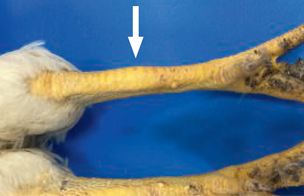7/18/2023:
The first months of 2023 saw an increase in the number of animals submitted for pathology whereby GD detected reovirus in the tendon sheath. Reoviruses are (very) common in chickens. The genetic material of reoviruses is spread over multiple segments (a so-called segmented genome), which can be mutually exchanged between virus strains and which are also of a type (RNA) that can collect mutations relatively easier than our own genetic material (DNA), for example. The result is a very wide variety in reovirus strains. Most reovirus infections do not cause disease. However, there are strains that can multiply in the tendon sheath and cause damage there. The disorder caused by these viruses is therefore known as viral tenosynovitis. Chicks suffering from this disorder often have swollen tendons of their legs (see photo 1). The diagnosis is made by detecting the virus in these tendons (using a PCR test, for example), while also determining that there is indeed an inflammatory reaction in the tendon or tendon sheath consistent with a viral infection (by means of microscopic testing), as swollen tendon sheaths can also be caused by other diseases, such as a bacterial infection for example.
Further examination of the reovirus strains
Figure 1 shows the increased number of necropsies in the first half of 2023 whereby GD diagnosed viral tenosynovitis due to reovirus. The reovirus isolates from the necropsies were examined in more detail to determine whether they had spread from a specific source (for example a breeding flock), or whether a specific strain had been formed which then spread rapidly. The 2023 isolates were shown to belong to various genogroups: types 1, 2 and 4 were all detected multiple times.
This is therefore not a single new strain which spreads rapidly. Furthermore, infections were seen in a number of different breeds, and there is no association between a certain virus genotype and a certain breed. There is therefore no evidence that the rise in reovirus cases is linked to a certain breeding flock.
Horizontal spread between flocks is significant in reovirus. The virus can also remain present in an empty barn, to reinfect a new flock.
Reovirus in layers
Viral tenosynovitis is mainly seen in broilers or broiler parent stock. However, in 2023 an infection was seen in young layers (see photo 1). Although these animals are known to develop the disease, it is extremely rare in the field.

Photo 1. This young hen has a swollen tendon sheath (arrow). Reovirus was found in the tendon
sheath, along with microscopic symtoms of a viral inflammation (Source: GD)
You can also read this article in the highlights report poultry of June 2023
In this report you can also find more information on:
• Salmonella Pullorum
• Animal health barometer for poultry
Highlights report Poultry june 2023